RBSE Class 12 Biology Important Questions Chapter 7 Evolution
Rajasthan Board RBSE Class 12 Biology Important Questions Chapter 7 Evolution Important Questions and Answers.
Rajasthan Board RBSE Solutions for Class 12 Biology in Hindi Medium & English Medium are part of RBSE Solutions for Class 12. Students can also read RBSE Class 12 Biology Important Questions for exam preparation. Students can also go through RBSE Class 12 Biology Notes to understand and remember the concepts easily. Browsing through manav janan class 12 in hindi that includes all questions presented in the textbook.
RBSE Class 12 Biology Chapter 7 Important Question Evolution
Multiple Choice Questions
Question 1.
Genetic drift operates only in
(a) Island population
(b) smaller population
(c) larger population
(d) Mendelian population
Answer:
(b) smaller population

Question 2.
First photoautotroph organism were:
(a) Bryophytes
(b) Algae
(c) Cyanobacteria
(d) Bacteria
Answer:
(d) Bacteria
Question 3.
What is the most important for origin of life?
(a) Carbon
(b) Oxygen
(c) Water
(d) Nitrogen
Answer:
(c) Water
Question 4.
Missing link between reptiles and birds is:
(a) Dimetrodon
(b) Dodo
(c) Sphenodon
(d) Archaeopteryx
Answer:
(d) Archaeopteryx
Question 5.
Bribal Sahn institute of Palaeobotany is located at:
(a) Delhi
(b) Lucknow
(c) Dehradun
(d) Kalkata
Answer:
(b) Lucknow
Question 6.
Who proposed germplasm theory against Lamarck’s principle of use and disuse?
(a) Darwin
(b) Nuttal
(c) Weismann
(d) de - Vries
Answer:
(c) Weismann
Question 7.
Charles Darwin’s theory of evolution was based on:
(a) Environment
(b) Mutations
(c) Chromosome pairing
(d) Natural selection
Answer:
(d) Natural selection
Question 8.
Wing of an insect and bat exhibit:
(a) Homology
(b) Analogy
(c) Atavism
(d) Connecting link
Answer:
(b) Analogy
Question 9.
Which one of the following is a vestigeal organ in man?
(a) Cochlea
(b) Eye lid
(c) Pinna
(d) Vermiform appendix
Answer:
(d) Vermiform appendix
Question 10.
Theory of origin of life was given by:
(a) Darwin
(b) Mathus
(c) Oparin
(d) Trasley
Answer:
(c) Oparin

Question 11.
Origin of life took place in/on:
(a) Lord
(b) Water
(c) Air
(d) Mountains
Answer:
(b) Water
Question 12.
The branch dealing with study of fossils is:
(a) Exobiology
(b) Paleontology
(c) Ecology
(d) Ethology
Answer:
(b) Paleontology
Question 13.
Industrial melanism is an example is
(a) Natural selection
(b) Mutation
(c) Adaptive convergence
(d) Artificial selection
Answer:
(a) Natural selection
Question 14.
Which of the following is an example of living fossil?
(a) Sphenodon
(b) Archaeopteryx
(c) Chimpanzee
(d) Orangutan
Answer:
(a) Sphenodon
Question 15.
the hook ‘origin of species’ was written by:
(a) Darwin
(b) Hugo de Vries
(c) Lamarck
(d) Huxley
Answer:
(a) Darwin
Very Short Answer types Questions
Question 1.
When did life appear on earth?
Answer:
About 3500 - 2800 million years ago.
Question 2.
List the two theories of origin of life?
Answer:
Theory of special creation and chemosynthetic theory of origin of life.
Question 3.
What are coacervates?
Answerw:
Aggregates of complex organic compound showing sign of life.
Question 4.
Who were the supporter of Abiogeness theory?
Answer:
Thales, Anexinendar, Empedocles, Plato and Aristotle etc.
Question 5.
What substance did Miller obtain in his experiments?
Answer:
Amino acids, simple sugar and organic compounds.

Question 6.
Give or example of homlogous organs.
Answer:
Hand of man and wings of birds.
Question 7.
Give an example of analogous organs.
Answer:
Wing of insects and using of birds.
Question 8.
Who wrote the book ‘Philosophic Zoologique’?
Answer:
Lamarck (1809).
Question 9.
Name two vestigial organs of human body.
Answer:
Nictitating membrane, vermiform - appendix.
Question 10.
What is biogenetic theory?
Answer:
Organism repeats ancestors embryonic stages is its embryonic stage called biogenetic law.
Question 11.
By which method the age fossils are estimated?
Answer:
By carbon dating (C14) technique.
Question 12.
State the significance of the study of fossils in evolution.
Answer:
Fossils help us to know the morphological details of the organisms that were present in the past and relate them to the organisms of the present. For better understanding the process of evolution.
Question 13.
Name the common ancestor of a the great apes and man.
Answer:
Dryopithecus is the common ancestor of great apes and man.
Question 14.
Define genetic drift.
Or
Write the hypothetical proposals put forth by Oparin and Haldane.
Answer:
The changes occurring in frequencies of alleles by chance are called genetic drift.
Question 15.
List two main proposition of Oparine and Haldane.
Answer:
Two main proposition of aparin and Haldane were:
- The primitive atmosphere was reducing, i.e. free oxygen was absent.
- There was high temperature, high methane, amonia and hydrogen gas in the atmosphere.
Question 16.
On which continent Homo Sapeins arose?
Answer:
During a time of dramatic climate change 300,000 years ago Homo Sapiens arose in Africa continent.
Question 17.
Write the probable difference in eating habits of Homo habilis and Homo erectus.
Answer:
The probable difference in eating habit of Homo habilis and mbmo erectus are as follows:
- Homo habilis did not eat meat.
- Homo erectus probably ate meat.
Question 18.
Who propounded the biological evolution theory of use and disuse of organs.
Answer:
Jean Baptiste de Lamarck.
Question 19.
What role does an individual organism play as per Darwins theory of natural selection ?
Answer:
According to Darwins theory of natural selection, the role of an individual organism is to pass on the necessary variations, changes or mutations from present generation to the next generation, that has been selected by the nature.

Question 20.
Write the name of the following:
(a) A 15 mya primate that was ape - like
(b) A 2 mya primate that lived in East African grasslands.
Answer:
- Dryopithecus
- Australopithecus.
Question 21.
Mention one example each from plants and animals exhibiting divergent evolution.
Answer:
Plant - Baugainvillea thorn and Cucurbita tendril.
Animals - Forelimb of man, cheetah, whale, bate.
Question 22.
How did Charls Darwin express fitness.
Or
What is fitness of an individual according to Darwin?
Answer:
According to Darwin, fitness of an individual is the ability of an organism to reproduce successfully and leave a large number of progenies under a particular set of selection pressures.
Question 23.
Coelacanth was caught in South Africa. State the significance of discovery of Coelacanth in the evolutionary history of vertebrates.
Answer:
The discovery of Coelacanth (Lobefins), the first amphibian is significant as it proved that amphibians have evolved from fish - like organisms. Lobefin were the ancestors of modern day frogs and salamanders.
Short Answer Type Question - I
Question 1.
Define the terms evolution and evolutionary biology.
Answer:
Evolution: It is the process of continuous change and involves the trends like increased adaptation, complexity of structure and functional efficiency.
Evolutionary biology: Evolutionary biology is the branch of biology dealing with the study of history of like forms on earth.
Question 2.
How do palaeontological evidences support evolution of organisms on earth.
Answer:
Palaeontology is the study of past life based on fossils records.The study of fossils reveals the type of life forms occurring in the past and highlight the course evolution of living organisms. The distribution of fossils in the sedimentary rocks of different ages fully support the concept of evolution. It shows that structure of wing become more and none complex as we proceed from earlier to recent times. From the fossil records it has been concluded that evolution has taken place from the simple to complex form in a gradual manner.
Question 3.
Convergent evolution leads to analogous structures. Explain with the help of or example.
Answer:
Convergent evolution is a process of evolution, where anatomically dissimilar structure in different organism perform similar functions. It leads to the formation of analogous structures in different groups of organism perform similar function, but are anatomicalh different examples, potato (stem modification) and sweet potato (root modification), flippers of penguins and dolphins.
Question 4.
What do you understand by homologous organs? Give one example.
Answer:
The organs with same structural design and origin but different functions are called homologous organs.
For Example: Forelimbs of some animals like whales, bats and cheetah have similar anatomical structure. Such as humerus, radius, ulna, carpals, metacarpal and phalanges. But these forelimbs perform different functions in these animals.
Question 5.
What do you understand by analogous organs? Give one example.
Answer:
Organs which are anatomically different but functionally similar are called analogous organs.
For Example: Wings of butterfly and birds. In both organisms wings perform same function but they have different origin and structure.
Question 6.
Differentiate between Natural and Artificial Selection.
Answer:
Difference between Natural and Artificial Selection.
|
Natural Selection |
Artificial Selection |
|
1. Natural selection is exerted by nature. |
1. Artificial selection is exerted by man. |
|
2. Natural selection is responsible for the great biological diversity seen in the living world. |
2. Artificial selection produces new varieties that are different from the starting generation. |
|
3. This process operates in natural population. |
3. This process operates in domestic population. |
|
4. Natural selection selects or favours characters that are of the survival value to the organism. |
4. In artificial selection the breeder selection features are of interest or benefit to human. |
|
5. It is a very slow process and takes thousands millions of years. |
5. It is fast process and its results are immediate. |
Question 7.
Differentiale between Sympatric and allopatric speciation.
Answer:
Difference between Sympatric and Allopatric speciation
|
Sympatric Speciation |
Allopatric Speciation |
|
1. It occurs in those population that occupy the some geographical areas. |
1. It occurs in those population that occupy different geographical area. |
|
2. Sympatric Speciation is sudden. |
2. Allopatric speciation is gradual. |
|
3. It occurs by the sudden appearance of reproductive isolation in the individuals of a single population. |
3. It occurs in different population of the some species by the gradual accumulation of variations & mutations. |
|
4. The sympatric species are isolated only by ecological and ethological or by genetic isolation. |
4. Allopatric species are initially isolated by geographic isolation and accumulate genetic difference in due of course. |
Question 8.
Differentiate between Divergent and convergent evolution.
Answer:
Differentiate between Divergent evolution and convergent evolution
|
Divergent Evolution |
Convergent Evolution |
|
1. Divergent evolution results in origin of new forms are different from the existing forms. |
1. Convergent evolution results is origin of new forms which resemble in appearance to the already existing forms. |
|
2. A group split into a number of groups, each with different appearance. |
2. Organism of different groups assume similar habitat. |
|
3. Organisms get adapted to different environment of different habitats. |
3. Organisms get adapted to one environment for one habitat. |
Question 9.
What is founder effect?
Answer:
When a small group of individuals from some large population invades a new or isolated geographical region, these act as founder members. They carry limited portion of the parental gene pool. The descendant of these founders in an isolated area will inherit the genes of their founders. The resemblance of the gene pool of descendants of these founders was called founder’s effect by Mayr.
Question 10.
Why is percent oxygen supported to be toxic to aerobic life forms ?
Answer:
Nascent Oxygen is toxic to aerobic forms because nascent oxygen is highly reactive. It can react with different organic molecules like protein, carbohydrates and DNA present inside the cells of aerobic forms, this will lead to mutations (changes in DNA) and undesirable changes of metabolic level.
Question 11.
“Migration may enhance or blurr the effect of selection.” Comment.
Answer:
Migration involves both immigration and emigration. Immigration adds new gene complements to the population’s gene pool and emigration removes gene complement from the gene pool. Thus migration may add those alleles that are being selected or favoured by nature enchancing the effect of selection; or may remove these alleles (due to emigration) which are being founded by nature.

Question 12.
You have studied the story of pepper moths in England. Had the industries been removed, what inspect could it have on the moth population ? Discuss.
Answer:
Due to the removal of industries in England, there will be no soot in the atmosphere. The non - sooty environment will support the survival of non melanic grey variety of pepper moth. The melanic variety will be gradually eliminated because birds will locate them on the tree trunks and will prey on them.
Question 13.
Explain with the help of on example the type of evolution homology is based on.
Answer:
Divergent evolution is process, where the same structure develpp along different directions in different organism due to adaptation to different needs. Divergent evolution leads to the development of homologous structure. As they all have same anatomical structure and origin, but perform different functions. Example: The thorns of Bougainvillea and tendrils of Cucurbita are homologous organs as both of them are modified axillary buds. Which perform different function.
Question 14.
What is adaptive radiation? Explain with an example.
Answer:
Adaptive Radiation: Organism of the some group or closely related groups when occupy different habitats, they assume different appearance and their homologous structures exhibit great livergence in form and function. This is called adaptive radiation.
Example: Darwins Finches are best examples of adaptive radiation.
Question 15.
Explain homology and analogy in animals by giving examples.
Answer:
Homology: It is the relation among the organs of different groups of organisms, that show similarity in the basis structure and development, but have different function.
Examples: Forelimb of man, cheetah, whale, Bat Analogy: It is the relation among the organs of different groups of organisms, that show dissimilarity in the body structure and development, but have same functions.
Example: Wing of insect, bird, and bat.
Question 16.
Name the first human - like hominid. Mention his food habit and brain capacity.
Answer:
Homo habilis were the first human like hominid.
The probably did not consume meat and their brain capacity was about 650 - 850 cc.
Question 17.
Mention the evolutionary significance of the following organisms
(i) shrews
(ii) Lobefins
(iii) Homo habilis
(iv) Homo erectus.
Answer:
(i) Shrews are the first mammals. They give rise to primitive primates, eg. tarsiers, of beginning the paleocene era.
(ii) Lobefines are the first amphibians modern days frogs and salamanders have evolved form them.
(iii) Homo habilis are the first human like primates. They were first and the most skillful tool markers.
(iv) Homo erectus appeared after Homo habilis about 1.7 mya. They had large brain capacity i.e. 800 - 1100 c.c.
Question 18.
With the help of an algebraic equation how did Hardy - Weinberg explain that in a given population the frequency of occurrence of alleles of gene is supported to remain the same through generations?
Answer:
Hardy- Weinberg’s principle states that allels frequencies in a population are stable. They remain constant from generation to generation. The gene pool also remains constant. This is called genetic equilibrium. Thus according to this principle, the sum total of all the allele frequencies in a population always 1. Suppose in a diploid individual, pand q represent the frequency of allelic A and allele a, respectively. The probability that an allele A with a frequency of p appears on both the chromosomes of a diploid organism in the p2.
Similarly of aa is q2, of Aa is 2pq.
Hence p2 + 2pq + q2 = 1
The difference measured in the expected value of frequencies, indicates the extent of evolutionary changes.
Question 19.
If in a population of size ‘N’ the birth rate is represented as 'b' and th death rate as 'd' the increase or decrease in 'N' during a unit time period 't' will be:
\(\frac{d \mathbf{N}}{d \mathbf{t}}\) = (b - d) x N
The equation given above can also be represented as:
\(\frac{d \mathbf{N}}{d \mathbf{t}}\) = r x N, where r = (b - d)
What does 'r' represent. ? Write anyone significance of calculating 'r' for any population.
Answer:
r = intrinsic rate of natural increase.
'r' = value help to determine the impact of biotic and a biotic factor on the population growth.
Question 20.
State ‘two’ observations made by German naturalist, Alexander von Humboldt during his extensive explorations in South American jungles.
Answer:
Alexander von Humboldt during his extensive explorations in South American jungles made the following observations. Within a region species richness increases with increasing explored area but only upto a limit This relation for a wide variety of taxa turns out to be a rectangular hyperbola.
Question 21.
Wings of birds and wings of butterflies contribute to locomotion. Explain the type of evolution such organs are a result of.
Answer:
Wings of butterfly and wings of birds are analogous as they share a common function but the would not same structure. As the convergent evolution creates analogous structure that have similar function.
Short Answer Type Questions - II
Question 1.
What do you understand by Theory panspermia? Who revived this theory? Write down the objections of this theory.
Answer:
Theory of Panspermia: Early Greek thinker believed that life in the form of resistant spares come to the earth from other plants along with meteorites and spaceship. Richter (1865) revived this theory and called these resistant spores poanspermia. It was supported by Arrhenius (1908).
Objections: The existence of life on any other planet is not known so far. Morever, living matter cannot with. stand, the extreme cold and dryness and intense radiation of cosmas while travelling to the earth. Finally, this theory does not explain how life originated.
Question 2.
What do you understand by oxygen revolution? Explain ozone formation in ozonosphere.
Answer:
The evolution of oxidising atmosphere resulted in oxygen revolution and put on end to abiotic synthesis because the organisms consumed and degraded intermediate products formed abiotically. The oxygen revolution resulted in the evolution of new forms.
An ozonoshpere developed by the reaction of oxygen under the influence of UV radiation:
O2 + 2O2 → 2O3 (Ozone)
Accumulation of ozone layer in atmosphere formed a protective layer that acts as a radiation belt. It protects earth and life form high energy IV- radiations.
Question 3.
what are fossils? How the age of the fossils determined?
Answer:
The study of fossils of animals and plants that in past is called Palaeontology or Palaeobiology. The fossils are the remains or impressions of ancient organisms preserved by natural means in some medium i.e. rocks or otherwise. Fossil records have helped in building the broad historical sequence of biological evolution Leonardo Da vinci (1452 - 1519) of Italy is called the Father of Paleontology and Cuvier (1800) is the Founder of Modern Paleontology. Study of plant fossils is called palaeobotany and of animal fossils is paleozoology.
Formation of Fossils:
Fossils are formed in different ways based on the environmental conditions. The fossils may include original remains of the hard part (bones, teeth, shell etc.) in the sedimentary rocks, petrifaction of hard and soft parts, carbonised film, molds (impression of organisms in rocks), casts (molds filled with foreign material) and as actual remains in peat, amber, asphalt and ice. Land animals have been found preserved in amber (hardened resin), asphalt (hardened tars, volcanic ash, ice, peatbogs and and deposits.
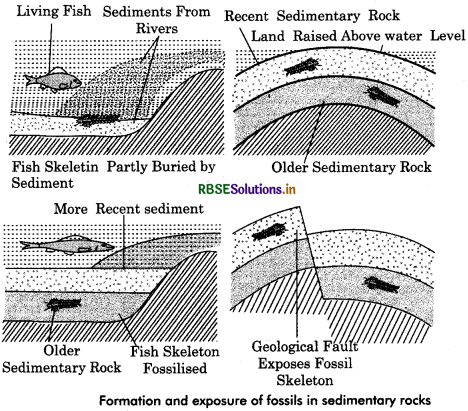
Question 4.
What do you understand by missing link? Give any two examples of missing links.
Answer:
Missing Links (Transitional Forms): The transitional fossil organisms which possess characters of two different groups of present day living forms are known as:
Missing links: These show evolutionary relationship between these group and are also called connecting link. They help in establishing the evolutionary sequence of major vertebrate group as follows:
Fishes → Amphibta → Replies → Binds, Mammals.
Examples of Missing Links:
1. Archaeopteryx lithographica: It is a connecting link between reptiles end birds. It fossil was discovered by Andreas Wagner in 1861 from limestone rocks of Solenhofen in Bavaria Germany. These rocks were of upper Jurassic period about 180 million years old.
Reptilian Characters:
- Presence of teeth in jaws
- Fingers having of claws
- It has long tail with free caudal vertebrae
- Presence of scale and
- Sternum without a keel.
Avian Characters:
- Presence of feathers on the body
- Forelimbs modified into wings
- Jaws drawn into a beak
- Presence of v - shaped furcula or wishbone and limb bones and girdles bird - like.
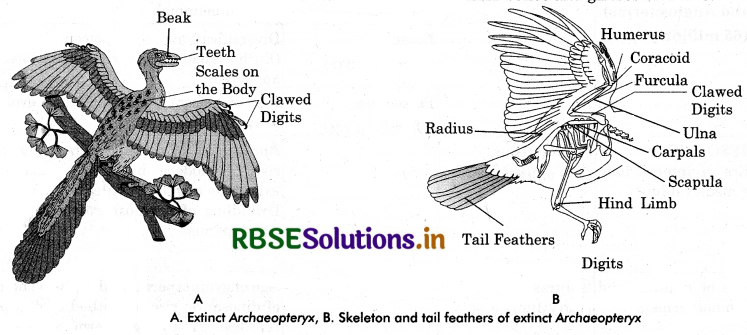
2. Cynognathus was a wolf - sized mammal - like reptile that lived in Triassic period. It resembled reptiles as well as mammals. It is regarded as ancient reptile encestors of mammals.
Question 5.
Differentiate between homology and analogy with example.
Answer:
Difference between homology and analogy.
|
Homology |
Analogy |
|
1. Similarities found in organs |
1. External morphological similarity found in organs of different organisms on the basis of same functions. |
|
2. The organs of similar basic structure are known as homologous organs. |
2. The organs of similar appearance are known as analogous organs. |
|
3. Example: (i) Fore limbs of man, whale and bat, (ii) Thorn of Bougainvillea and Tendril of Cucurbita. |
3. Example: (i) Wings of insect, bat and bird. (ii) Tubers of potato one sweet potato. |
Question 6.
What are vestigial organs? Name three vestigial organs of man.
Answer:
These organs are poorly developed or rudimentary organs or body parts that are non-functional and useless to the possesser, but were functional in the ancestors and are fully developed and functional in related forms. Vestigial Organs in Human : As many as 90 vestigial structures are found in our body. Some of them are : Nictitating membrane (third eyelid), ear muscles (auricular muscles) to move pinna, wisdom teeth, pointed canines, vermiform appendix, mammae in male, clitoris in female, abdominal muscles, caudal vertebrae. (Cocyx), hain coat etc.
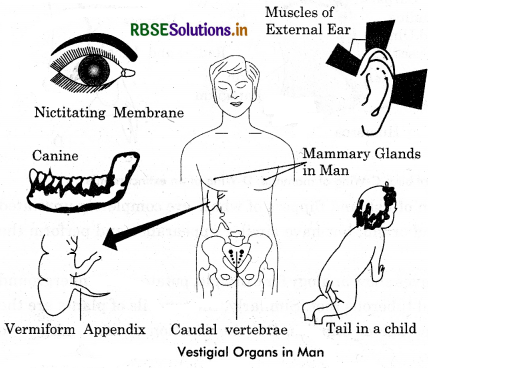
Vestigial Organs in other Animals:
- Vestiges of hindlimbs and pelvic girdles in Python and Sand boas due to fossorial living.
- Splint bones in horse limbs, which are adapted for foot running.
- Wings and feathers in flightless birds like ostrich.
- Vestigial eyes or eyes covered with a fold of integument in burrowing amphibians.
Vestigial Organs in Plants: Scale leaves of Ruscus and underground stem, cutinised stomata in cacti and rudimentary flagella in cycad sperms are some example of vestigial organs in plants.
Significance of Vestigial Organs: These organs were fully developed and functional in the ancestors, but with the change in habit, these were not needed by the organisms and haye gradually reduced to vestiges. The widespread occurrence of vestigial organs provides evidence for the occurrence of organic evolution.

Question 7.
What do you understand by connecting links? Explain any one example of connecting link.
Answer:
The living organisms having the characters of two different taxonomic categories are called connecting links. Such organisms form a bridge between the primitive and advanced groups. They suggest that the advanced group has evolved from the simple ones. Connecting links provide evidence for the process of evolution and theory of descent with modification.
Examples of Connecting Link:
1. Protopterus (Lung Fish): It is a connecting link between bony fish (in having paired fins, dermal scales, lateral line system and gills) and amphibians (in having internal nares, lungs and 3 - chambered heart).
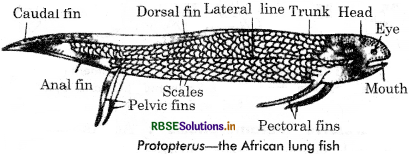
2. Ornithorhynchus (Duck - billed Platypus and Tachyglossus (Spiny ant - eater) are egg laying mammals.These act as connecting links between mammals (in having hair, diaphragm, mammary glands etc.) and reptiles (in having large coracoid, being oviparous, laying shelled and polylecithal eggs and having cloaca). So the prototherian are commonly called unfinished mammals.
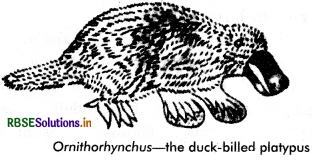
3. Euglena, a protozoan, is a connecting link between plants and animals. Like plants, it has chromoplasts and carries out photosynthis. Like animals it has pellicle, contractile vacuole and stores food in the form of glycogen.
Other Examples:
- Viruses: Connecting Link between living and non - livings.
- Proterospongia: Connecting link between protozoa and porifera.
- Peripatus: Connecting link between annelida and arthopoda.
- Neopilina: Between Annelida and Mollusca.
- Archaeopteryx: Between reptile and Aves.
- Balanoglossus: Between non - chordata and chordata.
Question 8.
Explain adaptive radiation with the help of a suitable example.
Answer:
Adaptive radiation is on evolutionary process in which on ancestral stock gives rise to new species that are adapted to new habitats and new ways of life. In other words, adaptive radiation is the evolution of organisms, starting from a point which then radiates or spreads to other habitats.Study of evolution of different plant and animal groups through ages reveals another phenomenon of adaptive divergence and adaptive convergence. Organisms of the same group or closely related groups when occupy different habitats,' they assume different appearances and their homologous structures exhibit great divergence in form and function. This is called adaptive radiation or adaptive divergence. Analogy indicates that distantly- related or totally unreleated animals develop similar adaptations for living in the same habitat. This is called adaptive convergence or convergent evolution.
Examples of Adaptive radiation or Adaptive Divergence:
Adaptive Radiation in Darwin's Finches: Darwin on his voyage on the ship H.M.S. Beagle to Galapagos island observed about 13 species of birds which are called Darwin’s finches. These finches species differ from one another in shape and size of their beaks and the type of food they take. The following types of beaks evolved from the staut, conical beaks of parental finches that lived on mainland of Africa and used to feed by crushing seeds.
- Vegetarian tree Finches: Developed Parrot - like beak to feed upon leaves, buds and fruits.
- Woodpecker Finches: Have short end stout beak for searching insects under the bark and leaf clusters.
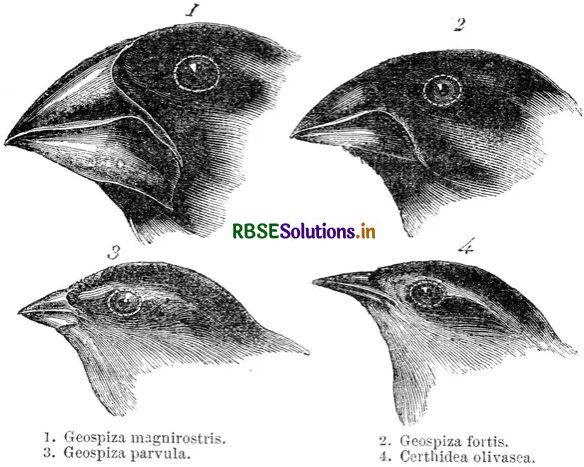
- Insectivorous tree Finches have short, thick and parrot - like beak to feed on beetles and other insects.
- Insectivorous Warller Finches developed silts waebler - live beak for cautch insects.
- Cactus Ground finches developed long and recovered beak to pear flowers or prickly rear cacti for nectar or to feed on saft pulp of cacti.
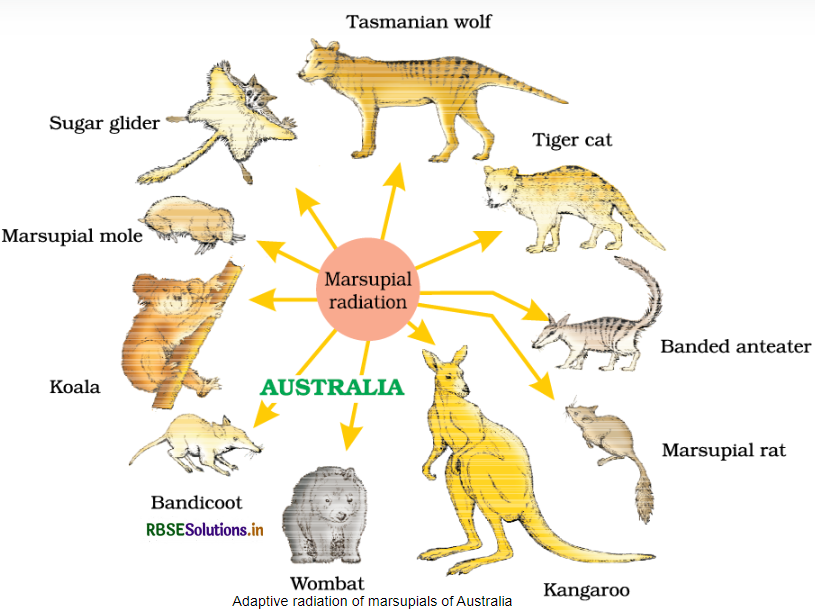
Question 9.
How do homologous organs represent divergent evolution? Explain with the help of a suitable example.
Answer:
Homologous organs as Divergent Evolution:
Homology is the relation among the organs of different groups of organisms, that show similarity in the basic structure and embryonic development, but have different function. Homology in organs indicates common ancestry. It is based on divergent evolution. When due to different needs, some structures develop differently, the condition is called divergent evolution. This results in the formation of homologous organs.
Example:
- Forelimbs of animals like whale, bat, cheetah and man.
- Thorn of Baugainvillea and tendrils of cucurbita in plants.
Question 10.
(a) Differentiate between analogous and homologous structures.
(b) Select and write analogous structures from the list given below:
(i) Wings of butterfly and birds
(ii) Vertebrate hearts
(iii) Tendrils of bougainvillea and cucurbita
(iv) Tubers of sweet potato and potato
Answer:
(a)
|
Homology |
Analogy |
|
1. Similarities found in organs |
1. External morphological similarity found in organs of different organisms on the basis of same functions. |
|
2. The organs of similar basic structure are known as homologous organs. |
2. The organs of similar appearance are known as analogous organs. |
|
3. Example: (i) Fore limbs of man, whale and bat, (ii) Thorn of Bougainvillea and Tendril of Cucurbita. |
3. Example: (i) Wings of insect, bat and bird. (ii) Tubers of potato one sweet potato. |
(b) Analogous organs
(i) Wings of butterfly and birds
(ii) Tubers of sweet potato and potato.
Question 11.
According to Darwinian theory of natural selection the rate of appearance of new forms is linked to the life - cycle or the life - span of an organism. Explain with the help of an example.
Answer:
The variations, indirectly the rate of appearance of new forms is linked to the life cycle or the life span. The individuals which have a short life span will show a high degree of variation over a fixed period of time (even days in case of microbes, in comparision to the individuals with along life cycle of life span. In the case of microbes which have the ability to multiply and become millions of individuals within hours in due cause of time, this resistant population autgrows the other and appears as a new species within few days. The same event in fish or owls would like million of years as the life span of these animals are in years.
Question 12.
Darwin on his voyage to Galapagos Island had observed finches having different varieties of beaks. Write the explanation he gave for his observations and the conclusions he arrived at.
Answer:
Darwin observed the variation in the beak of small black birds on Galapagos island due to their adaptation to different food habits. Darwin explained:
- All the varieties must have evolved within the same island itself. The original finches were seed eating. From them, some arose with altered beaks as insectivorous and some as vegetarian finches.
- This process of evolution of different species in a given geographical area starting from a point and radiating to other habitats is called adaptive radiation.
Question 13.
Explain Hardy - Weinberg principle.
Answer:
Hardy- Weinberg’s principle of Equilibrium proposed by G.H. Hardy and W. Weinberg (1908) independently to describe the relationship of gene frequencies and genotype frequencies of allels in the gene pool of a population.
The principle states that, if the evolutionary forces (mutations, selection etc.) are not operating on a large and randomly mating panmictic population, the relative frequencies of various alleles in that population tend to remain at an equilibrium or constant generation after generation. It means, if gene frequency in a population remain constant, the population is static and is not evolving. If we presume that in a Mendelian population:
(i) Gene frequency of gene A = p
(ii) gene frequency of its allele a = q
(iii) some of these allele (A + a) = p +q = 1
(iv) Gene types frequency of AR, Aa and aa genotypes.
= (p+ q)2(1)2 or = P2 + 2pq + q2 = 1
I. e. genotype frequencies of AA = p2 , genotype frequency of aa = q2
and genotype frequency of Aa = 2pq
If a population is large in size, its individuals have random mating. Each parent produces roughly equal number of gametes. These gametes combine at random and undergo evolutionary changes, then the gene or allele frequency of various genes remains constant or unchanged and genetic equilibrium of genes is preserved through generations.
Question 14.
Write short notes on the following:
(a) Bottleneck effect
(b) Founder Effect
Answer:
(a) Bottleneck Effect or Sampling Error: The seasonal phenomenon of cyclic fluctuations in population size is present in large varieties of individuals. In such cases, population erash leads to eradications of majority of individuals leaving only a few to survive. These few surviving individuals become profounder for the future generation. The population in next generations may increase in size dramatically to undergo another population crash but may lack some of the allele because their profounder were without those alleles. Such a phenomenon causing reduction in the allele frequencies and loss of some alleles from the gene pool in a random fashion is known as bottleneck phenomeon. This cause loss of certain alleles by chance. It reterds the ability of the population to re-establish its genetic richness.
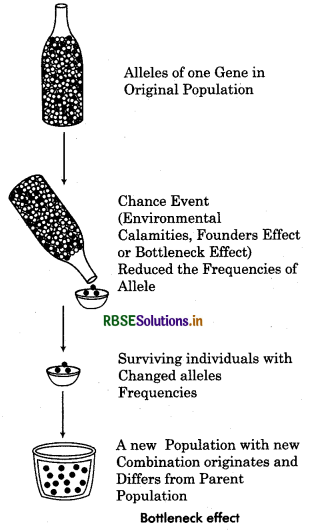
(b) Founder's Effect: The founder effect is the reduction in a genetic variation or dramatic changes in the frequencies of alleles, that result when a small subset of a large population is used to establish a new population. The new population may be very different from the original population, both in terms of its genotypes and phenotypes. The founders (small subset) carry only a limited portion of parental gene pool. Their gene pool may be homozygous for certain traits thereby lacking the other alleles for these traits or character. It means different founder colonies will possess different gene pools and will soon become different from each other and from parental population. Such an effect is called Founder effect.
Question 15.
Give the history and feature of cro - magnon man.
Answer:
History of Human Evolution: The first attempt to man’s origin is made by T.H. Huxley (1863) in his book Man’s place in Nature and visualised apes as the closest relatives of man. Charles Darwin (1871) advocated his thought about man’s ancestry in his book The Descent of Man. However, scientific studies about human evolution began about one hundred years ago. Most pre - human fossils were discovered from 1920 onwards. The first fossil of human ancistors were unearthed by Eugene Dubois in the early 1890s.
Roymond Dart, W.C. Pei, Louis and Mary Leaky, their son Richerd and Bernard Nigeneo, etc. Contributed to preparing tree of human evolution.
Place of Human Evolution : The fossils of earliest hominids were found from Africa, China and Siwalika Hills in India. According to monophyletic origin, modern man has evolved in single locality in Africa. But according to polyphyletic origin, human evolution has occurred simultaneously in different unconnected localities in the old Africa. Though the cradle of human evolution is considered to be Africa, central Asia, China, Java and India. Man’s origin is considererd to be about 15 mya from some common ancestral hominids stock which induced ancestor of both apes and men.
Man’s nearest relatives are monkeys and apes, i.e. Gibbon, Chimpanzee, Gorilla and Orangutan. They are tailless branchiators and walk on the edges of feet and Knuckles. Apes, human and their common ancestors are collectively known as hominoids, while man and their ancestors are called hominids. Both apes and men are regarded to have evolved simultaneously from some common ancestors.
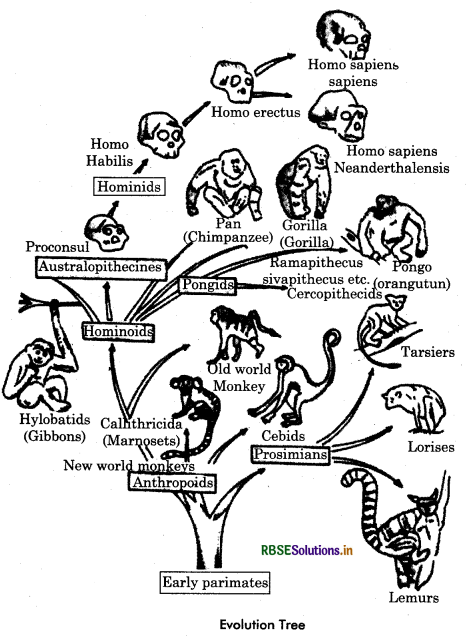
Long Answer Type Question
Question 1.
Explain four theories of ‘origin of life’ and gives detailed explanation of oparin’s theory.
Answer:
Various hypothesises and theories have been put forward to explain the origin of life from time to time.
Some of them as follows:
1. Theory of Special Creation: This theory was proposed by Father Saurez according to special creation theory, all living organism (i.e. animal and plants) including human, existing today were created by the God or creater. These forms were designed according to their surroundings all of a sudden.
Accordings to Christianity, the world was created by God in six days from material prima. On the first day, the heaven and the earth were created, sky and sea on the second day, dry lands and plants on third day, sun, moon and stars on fourth day, fish and fowl on fifth day and animals including man and beasts were created on sixth clay. The first man, Adam was formed from day while the first woman, Eve, was created from his 12th rib. According to Hindu mythology, Lord Brahma created different forms of life from different parts of his body. These theories are purely a religious concepts and have not scientific fact. Hence, these are not accepted by the scientists.
2. Theory of Catastrophism: According to this theory, the earth has undergone several Various hypothesises and theories have been put
forward to explain the origin of life from time to time.
Some of them as follows:
1. Theory of Special Creation: This theory was proposed by Father Saurez according to special creation theory, all living organism (i.e. animal and plants) including human, existing today were created by the God or creater. These forms were designed according to their surroundings all of a sudden. Accordings to Christianity, the world was created by God in six days from material prima. On the first day, the heaven and the earth were created, sky and sea on the second day, dry lands and plants on third day, sun, moon and stars on fourth day, fish and fowl on fifth day and animals including man and beasts were created on sixth clay. The first man, Adam was formed from day while the first woman, Eve, was created from his 12th rib. According to Hindu mythology, Lord Brahma created different forms of life from different parts of his body. These theories are purely a religious concepts and have not scientific fact. Hence, these are not accepted by the scientists.
2. Theory of Catastrophism: According to this theory, the earth has undergone several catastrophes and each catastrophe destroyed whole life. After every catastrophe, the creator created a new living world which was quite different from the previous one. This theory is almost similer to the theory of special creation.
3. Theory of Cosmozoic Creation: This theory was proposed by Arrhenius. According to this theory, life came on the earth from some other planet in the form of spores called Panspermia. Scientists, Richter (1865), Hoyle (1950), Bondy (1952) etc. believed in “Eternity of Life”. According to them, the question of ‘origin of life’ does arise not at all. Then scientists supported terrestrial origin of life also. This theory is also disapproved now, because the universe has been found so cold, dry and radiating that ho life can survive on it. Moreover, this theory is not able to answer the basic questions of ‘origin of life’.
4. Theory of Spontaneous Generation or Abiogenesis or Autogenesis: Before the end of 17th century, philosophers and scientists believed that living things on the earth originate spontaneously from non - living matter. Aristotle, Anaximader, Empedoceles and Xenophanes were the main propounders of this theory. According to Aristotle, insects originated from dew, frogs and toads from muddy bottom of pounds, fly maggots from flesh, butterfly from cheese, and tapeworm from excreta of animals. Van Helmant (1662) committed that young mice could arise from wheat chaff in 21 days when this were put in a dark place along with a sweaty dirty shirt. This theory was experimentally rejected by Francisco Redi (1628 - 1698), Spallanzani (1765) and Louis Pasteur (1822 - 1895), who proposed theory of Biogenesis.
5. Theory of Biogenesis: According to this theory “Life can arise from pre - existing life’ not from the non - living matter by abiogensis. Following are some evidences that support this theory.
Question 2.
(a) Draw a neat and labelled diagram of Stanley millers experiment.
(b) Which molecules were found by miller in U- tube of his apparatus?
Answer:
(a)
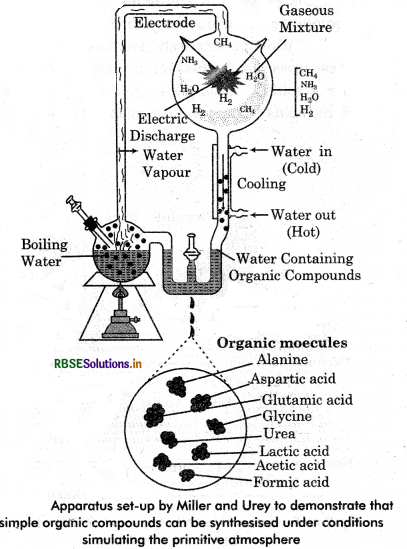
(b) Experimental Proof of Abiogenic Molecular Evolution of Life:
In 1953, Stanley L. Miller and Harold C. Urey experimentally proved the formation of simple organic compounds from simpler compounds under reducing conditions. It was aimed to assess the validity of Oparin and Haldane claim for origin of organic molecules in the primeval Earth condition.
For their experiment Miller and Urey simulated the conditions of primitive earth. They mixed ammonia, methane and hydrogen in 2 : 2 : 1 ratio, in a big 5 litre flask. A "500 ml flask, containing water was connected to the big flask by a glass tube to provide a continuous supply of water vapour or stream to the larger flask. Two tungsten electrodes, connected to an electric source, were fitted to the big flask to provide energy to electric discharge, simulating the effect of lighting of the primitive atmosphere.
The sparking of high electric current were produced, flowing 60,000 volt electric current between the electrodes for 7 - 8 days. On the other side, the larger flask was connected to a small U - tube by means of a straight tube passing through a condenser. When the experiment has continued for about a week, the gas formed (mixed with the circulating water vapour) as dark - red liquid in the U - tube . After about one week, the liquid was found to contain a number of amino acids, such as glycine, alanine, and aspartic acid and simple sugars.
By the above experiment it was clear that various complex compounds are formed by the chemical combination of carbon, hydrogen, oxygen and nitrogen, which is biologically important. Melvin - Calvin (1951) obtained amino acids and sugars by treating a mixture of hydrogen, water vapour, ammonia and methane. Thus the essential building blocks of macromolecules (the amino acids and nucleotides) of living organisms could have been formed on the primitive earth. Ultimately, the amino acids sugars, glycerol, fatty acids, simple sugars etc. of the primitive ocean polymerized, i.e. their molecules joined together as monomers, forming larger linear polymers or macromolecules such as protein, carbohydrates and fats.
Since these macromolecules are the main constituents of the possibilities of ‘origin of life’ in the primitive ocean. Synthesis of protein was maximal because various amino acid molecules have the strongest tendency of polymerisation into long chains. As a consequence to the above ‘Chemical evolution’ the oceanic water became a rich mixture of organic compounds. Haldane termed it the hot, dilute soup of organic substance or “pre - biotic soup”.

Question 3.
How do embryological evidences support organic evolution? Explain with examples.
Answer:
The early embryos of all the vertebrate resemble in shape and structure. They have similar head with eye and ear rudiments, similar visceral arches and visceral furrows, similar segmentally arranged somites and a similar embryonic tail. Later, many of them grow limb-buds and develop internal organs in the same way. The resemblance in some cases so close that it becomes difficult to tell them apart. This similarity among the early embryos show that all the vertebrates have evolved from a common ancestor and they possess a common heredity that expresses their similarities in the embryonic life.
Recapitulation Theory and Biogenetic Law : The recapitulation theory was proposed by Von Baer (1828). It was revised and renamed biogenetic law by Ernst Haeckel (1968). It states that an animal in its individual development from egg to adult repeats or recapitulates in a condensed form the stages through which its ancestors have passed in the course of their evolution. This statement can be briefly put in these words- ontogeny repeats phytogeny. Ontogeny is the life history of an individual animal, phylogeny is the evolutionary history of races of the animal. This means an organism repeats its ancestral history during its development.
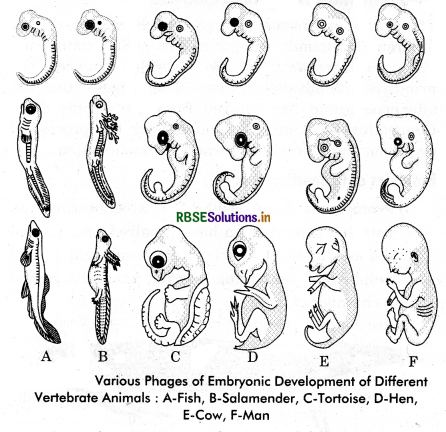
Retrogressive Metamorphosis: Adults of certain animals have degenerated features and do not show any resemblance with other animals of their group or any other group (have. But their larva have helped in establishing their phylogenetic relationship. For example, Herdmania is an ascidian. Its chordate nature has been established from the larva, which possesses all the there fundamental chordate characters.‘The adult ascidian has a purse - like body with no chordate characters.
Neotany: In larva of some animals, metamorphos is does not occur and reproductive organs are formed in these larva. These larval start reproducing sexually like adult. This phenomenon is known as neotany. For example, Salamander of Urodella class, and Amphystoma larva show neotany. This is called axolotle larva. Neotany of embryonic characters or primitive characters provides the evidence of evolution. During favourable conditions, natural selection inspires the primitive characters.
Question 4.
Give a brief account of Darwins theory of natural selection.
Answer:
The term ‘Darwinsm’ is coined for the explanation, ‘The Origin of Species by Natural Selection’ presented by Charles Darwin (1809 - 1882). Alfred Russel Wallace (1823 - 1913), an English biologist also arrived at the same conclusion independently. Theory of Natural Selection was announced on June 30th, 1858 by Charles Darwin and Alfred Russel Wallace.
Darwin's Observations:
Darwin travelled as a naturalist around the world on a survey ship, named H.M.S. Beagle in 1831. His Voyage lasted for 5 years (1831-1836). During his voyage, Darwin visited South America, Australia, South- East Asia, Southern tip of Africa, and a number of Islands including Galapagos Islands. Darwin observed and collected samples of various Flora and Fauna, mammalian fossils and coral reefs and prepared detailed notes. In Galapagos Island he also observed 13 different types of birds belonging to the family Geospizidae. He described his observations in his book Naturalist Voyage Around the world.
Darwins observations were:
- Different islands, which are widely separated but have similar climate and topography, have different Flora and Fauna.
- The animals and plants found on nearby islands are related but differ amongst themselves and also from those found on mainland.
- The same groups of plant and animals from different areas also exhibit differences.
- In Galapagos islands Darwin found 13 species of finches, each species occupying a different island. These differed from each other as well as from the finches present on the mainland of south Amercia, from which they all are supposed to have evolved. These birds are popularly known as Darwins Finches.
- Darwin collected fossils and noticed that while some fossils resembled modern day plants and animals, other were much different and primitive.
In 1958 Thomas Malthus sent his essay to Darwin. The thinking of both Darwin and Wallace in respect of organic evolution was greatly influenced by essays on ‘Principles of Population’ written by T.R. Malthus. Joint papers of Darwin and Wallace entitled ‘Origin of Species’ was published in the proceeding of ‘Linnean society of London’ in 1958. In his article Malthus had proposed that living organism multiple in geometric ratio, whereas the space and food resources etc. remain constant.
Principles of Darwinism:
- Enormous Fertility in Organisms
- Limited Food and Space
- Struggle For Existence
- Variations
- Natural Selection or Survival of the Fittest
- Inheritance of Useful Variations
- Speciation
Question 5.
Write down evidences in support of Darwinism and criticism of Darwinism.
Answer:
Criticism of Darwinism: Darwinism is not able to explain:
- The inheritance of small variation in those organs which can be of use only when fully formed, e.g. wings of bird. Such organs will be of no use in incipient or underdeveloped stage.
- Inheritance of vestigial organs.
- Inheritance of over - specialised organs e.g. antlers in deer and tusk in elephants.
- Did not differentiable between somatic and germinal variations.
- Presence of neuter flowers and sterility of hybrids.
- He did not explain the causes of the variations and the mode of transmission of variations.
- It was also rebutted by Mendel’s law of inheritance which state that inheritance is particulate.
Question 6.
Differentiate between Darwinism and Neo - Darwinism.
Answer:
Differentiate between Darwinism and Neo - Darwinism
|
Darwinism |
Neo - Darwinism |
|
1. Theory of origin of species was proposed by Darwin. |
1. Theory modified by Darwin’s supporters to explain mechanism of origin of species based on latest information. |
|
2. Individuals |
2. Populations are the units of evolution. |
|
3. Darwin did not differentiate between somatic and germinal (nomnheritable and heritable) variations. |
3. According to Neo - Darwinism, variations, may be heritable or germinal and non - heritable or somatic. |
|
4. Natural selection operates through survival of the fittest. |
4.Natural selection operates through |
|
5. Genetic drifts were not drawn to Darwins. |
5. Role of genetic drifts in introducing variation in the gene pool was empharised in case of small and isolated population. |
|
6. Did not recognise isolation and its role in evolution. |
6. Isolation of a population or species into smaller groups is essential for the origin of new species. |
|
7. Darwin has no idea about genes, gene and gene pools. |
7. The gene pool of the population evolves. |
|
8. All useful variations are heritable. |
8. Only generical variations are passed on to the next generation. |
Question 8.
Explain two postulates of Larmarkism.
or
Exaplaion:
(a) Use and disuse of organs
(b) inheritance of acquired character.
Answer:
(a) Use and disuse of organs:
The new habits involve the greater use of certain organs gain new needs, and the disuse or lesser use of certain other organs which are of no use in new conditions. The use and discuss of organs greatly affect the form, structure and functioning of the organs. Continuous and extra use of organs make them more efficient while the continued disuse of some other organs lead to their degeneration and ultimate disappearance. Hence Lamarckism is also called Theory of Use and Disuse of Organs. The organism acquires certain new characters due to direct or indirect environmental effects during its own life span and are called Acquired or Adaptative characters.
(b) inheritance of Acquired Characters:
According to Lamarck, acquired characters are inheritable and are transmitted to the offspring so that these are born fit to face the changed environmental conditions and the chances of their survival are increased.
Question 9.
(i) List any four evidences of evolution.
(ii) Explain any one of the evidence that helps to understand the concept of evolution.
Answer:
(i)
(a) Palaeontology
(b) Comparative anatomy and morphology.
(c) Biogeographical evidences.
(d) Embryological evidences.
(ii) Evolutionary History of Groups:
Fossil records of different classes of vertebrates appears in chronological sequence. Fossil fishers are first vertebrates, amphibians next, followed by repatiles and than birds and mammals.
Evolutionary History of Individual Forms:
The palaeontologists have traced out the complete evolutionary history of some animals such as horse, camel, elephant and man by the study of fossils.
Evolutionary History of Horse:
Fossil study of horse is a very important and solid evidence of evolution. Evolution of horse was described by Othniel C. Marsh in 1879. The history of horse started about 60 million years ago in the plains of North America, the ancestors of horse were small-sized, fox-like forms present in Eocene period of coeonizois era. They had four toes in forefoot and three toes in the hind foot. They increased in size and acquired modifications to suit grassland life for fast running. The gradually change of a character in a specific direction with and evolving lineage is called evolutionary trend. A lineage may show several trends both progressive or retrogressive.
Question 10.
Differentiate between analogy and homology giving one example each of plant and animal, respectively.
Answer:
|
Homologous Organs |
Analogous Organs |
|
1. They have same basic structural plan and similar origin. |
1. They have totally different structural plan and different origin. |
|
2. They differ in appearance. |
2. They have similar appearance. |
|
3. They are modified to carry out different functions. |
3. They develop to carry out the same function. |
|
4. They have similar internal structure. |
4. They have different internal structure. |
|
5. They are found in closely related organisms which arise from some common ancestor. |
5. They are found in totally unrelated organisms. |
|
6. They lead to adaptive radiation as divergent evolution. |
6. They lead te adaptive convergent or convergent evolution. |
Question 11.
Describe S.L. Miller’s experiment. Comment on the observations he made and his contribution towards the origin of life on Earth.
Answer:
In 1953, Stanley L. Miller and Harold C. Urey experimentally proved the formation of simple organic compounds from simpler compounds under reducing conditions. It was aimed to assess the validity of Oparin and Haldane claim for origin of organic molecules in the primeval Earth condition.
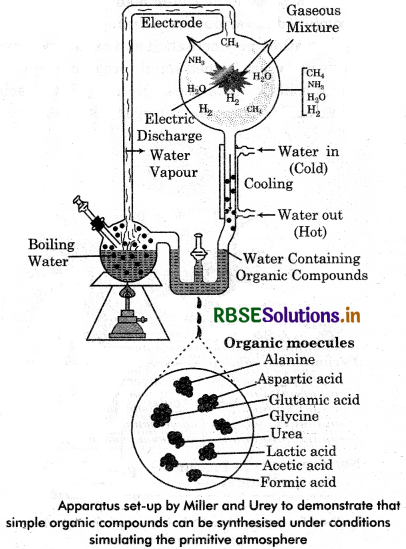
For their experiment Miller and Urey simulated the conditions of primitive earth. They mixed ammonia, methane and hydrogen in 2 : 2 : 1 ratio, in a big 5 litre flask. A "500 ml flask, containing water was connected to the big flask by a glass tube to provide a continuous supply of water vapour or stream to the larger flask. Two tungsten electrodes, connected to an electric source, were fitted to the big flask to provide energy to electric discharge, simulating the effect of lighting of the primitive atmosphere. The sparking of high electric current were produced, flowing 60,000 volt electric current between the electrodes for 7 - 8 days.
On the other side, the larger flask was connected to a small U - tube by means of a straight tube passing through a condenser. When the experiment has continued for about a week, the gas formed (mixed with the circulating water vapour) as dark - red liquid in the U - tube . After about one week, the liquid was found to contain a number of amino acids, such as glycine, alanine, and aspartic acid and simple sugars.
By the above experiment it was clear that various complex compounds are formed by the chemical combination of carbon, hydrogen, oxygen and nitrogen, which is biologically important. Melvin - Calvin (1951) obtained amino acids and sugars by treating a mixture of hydrogen, water vapour, ammonia and methane. Thus the essential building blocks of macromolecules (the amino acids and nucleotides) of living organisms could have been formed on the primitive earth. Ultimately, the amino acids sugars, glycerol, fatty acids, simple sugars etc. of the primitive ocean polymerized, i.e. their molecules joined together as monomers, forming larger linear polymers or macromolecules such as protein, carbohydrates and fats.
Since these macromolecules are the main constituents of the possibilities of ‘origin of life’ in the primitive ocean. Synthesis of protein was maximal because various amino acid molecules have the strongest tendency of polymerisation into long chains. As a consequence to the above ‘Chemical evolution’ the oceanic water became a rich mixture of organic compounds. Haldane termed it the hot, dilute soup of organic substance or “pre - biotic soup”.
Question 12.
Answer the following questions based on the experiment conducted by S.L. Miller in 1953.
(a) Name the gases present in the closed flask.
(b) Why was the flask fitted with electrodes?
(c) Write the observation he made.
(d) Sates the significance of the observation made by him.
Answer:
(a) Methane, Ammonia, Hydrogen and water vapour.
(b) The flask was fitted with electrodes to create electric discharge at 800° C.
(c) He observed the formation of amino acids in U - shaped tube.
(d) The significance of observation made helped to formulate the theory of abiogenesis, i.e. the first form of life arose slowly through evolutionary forces form the non - living molecules.

Question 13.
State the hypothesis proposed by oparin and Haldane. Describe how S.L. Miller experimentally supported it.
Answer:
This theory was proposed by a Hussian biochemist A.I. Oparin (1923) and was supported by a British Scientist, J.B.S. Haldane (1928). This theory is also called Oparin Haldone Theory. It stated that primitive life originated in the water, bodies on the primitive earth from inanimate matter by chemical evolution through a series of chemical reactions, about 4 billion years ago (i.e. about 500 million year after formation of earth ; in the precambrian period). It is most accepted theory because it has a scientific explanation and has been tested experimentally.
In 1836, Oparin presented his views in his book “The Origin of Life”. According to him:
- Abiogenesis under present condition is not possible but could have occurred under the conditions prevailing in the primitive atmosphere of primitive earth.
- Initial atmosphere of earth was reducing types, much different from present day oxidizing atmosphere.
- For chemical reactions, required energy was provided by high temperature, lightning and solar radiation.
- First living organisms arose from simple inorganic and organic compounds as a result of progressive series of chemical reactions (abiogenesis) by polymerisation.
- The process of transformation of the nonliving chemical into living matter extended over some one billion years or more. Lederberg (1925) considered three stages in the origin of life: Chemogeny, Biogeny and Cognogeny.
Chemogeny (Chemical Evolution)
About 4 billion years ago, the conditions on the earth, were such which favoured the chemogeny. When the surface temperature of earth was less than 100° C. Earth’s atmosphere had ammonia, methane, and water vapours. There was no free oxygen. So the primitive atmosphere was reducing.
In 1953, Stanley L. Miller and Harold C. Urey experimentally proved the formation of simple organic compounds from simpler compounds under reducing conditions. It was aimed to assess the validity of Oparin and Haldane claim for origin of organic molecules in the primeval Earth condition.
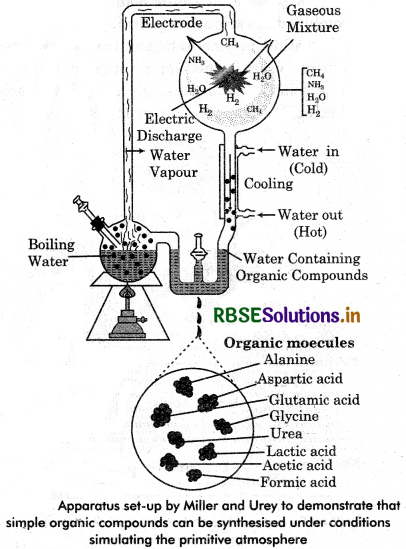
For their experiment Miller and Urey simulated the conditions of primitive earth. They mixed ammonia, methane and hydrogen in 2 : 2 : 1 ratio, in a big 5 litre flask. A "500 ml flask, containing water was connected to the big flask by a glass tube to provide a continuous supply of water vapour or stream to the larger flask. Two tungsten electrodes, connected to an electric source, were fitted to the big flask to provide energy to electric discharge, simulating the effect of lighting of the primitive atmosphere. The sparking of high electric current were produced, flowing 60,000 volt electric current between the electrodes for 7 - 8 days.
On the other side, the larger flask was connected to a small U - tube by means of a straight tube passing through a condenser. When the experiment has continued for about a week, the gas formed (mixed with the circulating water vapour) as dark - red liquid in the U - tube . After about one week, the liquid was found to contain a number of amino acids, such as glycine, alanine, and aspartic acid and simple sugars.
By the above experiment it was clear that various complex compounds are formed by the chemical combination of carbon, hydrogen, oxygen and nitrogen, which is biologically important. Melvin - Calvin (1951) obtained amino acids and sugars by treating a mixture of hydrogen, water vapour, ammonia and methane. Thus the essential building blocks of macromolecules (the amino acids and nucleotides) of living organisms could have been formed on the primitive earth. Ultimately, the amino acids sugars, glycerol, fatty acids, simple sugars etc. of the primitive ocean polymerized, i.e. their molecules joined together as monomers, forming larger linear polymers or macromolecules such as protein, carbohydrates and fats.
Since these macromolecules are the main constituents of the possibilities of ‘origin of life’ in the primitive ocean. Synthesis of protein was maximal because various amino acid molecules have the strongest tendency of polymerisation into long chains. As a consequence to the above ‘Chemical evolution’ the oceanic water became a rich mixture of organic compounds. Haldane termed it the hot, dilute soup of organic substance or “pre - biotic soup”.
Question 14.
Give an brief account of origin and evolution of man.
Answer:
Evolutionary Trends During Human Evolution:
During human evolution, following morphological characters have exhibited:
- Straight Posture
- Bipedal locomotion
- Straightening of forehead
- Formation of chin
- Narrowing of Nose
- Sparse body hair
- Development of distinct lumber curve
- Development of broad basin - shaped iliac bones in the pelvic girdle.
- Increase in size of brain and cranial cavity
- Acetabular cavities shifted inward to give straight posture
- Flattening of Face
- Loss of Suproarbital ridges
- Opposable thumb in the hand for grasping
- Thining of jaw bones
- Reduction in the jaw musculature
- Reduction in size of canines
- Increase in intelligence
- Social and cultural organisation

- RBSE Class 12 Biology Notes Chapter 16 पर्यावरण के मुद्दे
- RBSE Class 12 Biology Notes Chapter 15 जैव-विविधता एवं संरक्षण
- RBSE Class 12 Biology Notes Chapter 14 पारितंत्र
- RBSE Class 12 Biology Notes Chapter 13 जीव और समष्टियाँ
- RBSE Class 12 Biology Notes Chapter 12 जैव प्रौद्योगिकी एवं उसके उपयोग
- RBSE Class 12 Biology Notes Chapter 11 जैव प्रौद्योगिकी-सिद्धांत व प्रक्रम
- RBSE Class 12 Biology Notes Chapter 10 मानव कल्याण में सूक्ष्मजीव
- RBSE Class 12 Biology Notes Chapter 9 खाद्य उत्पादन में वृद्धि की कार्यनीति
- RBSE Class 12 Biology Notes Chapter 8 मानव स्वास्थ्य तथा रोग
- RBSE Class 12 Biology Notes Chapter 7 विकास
- RBSE Class 12 Biology Notes Chapter 6 वंशागति के आणविक आधार